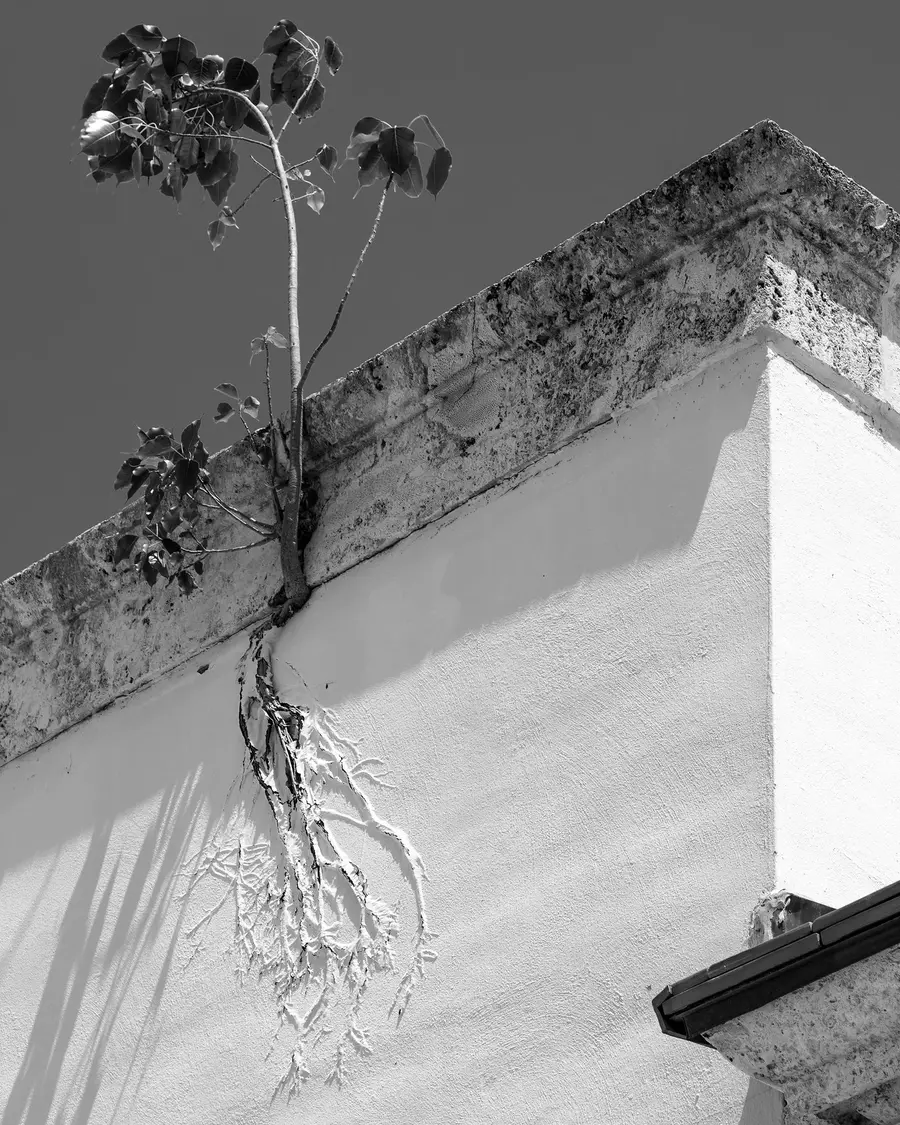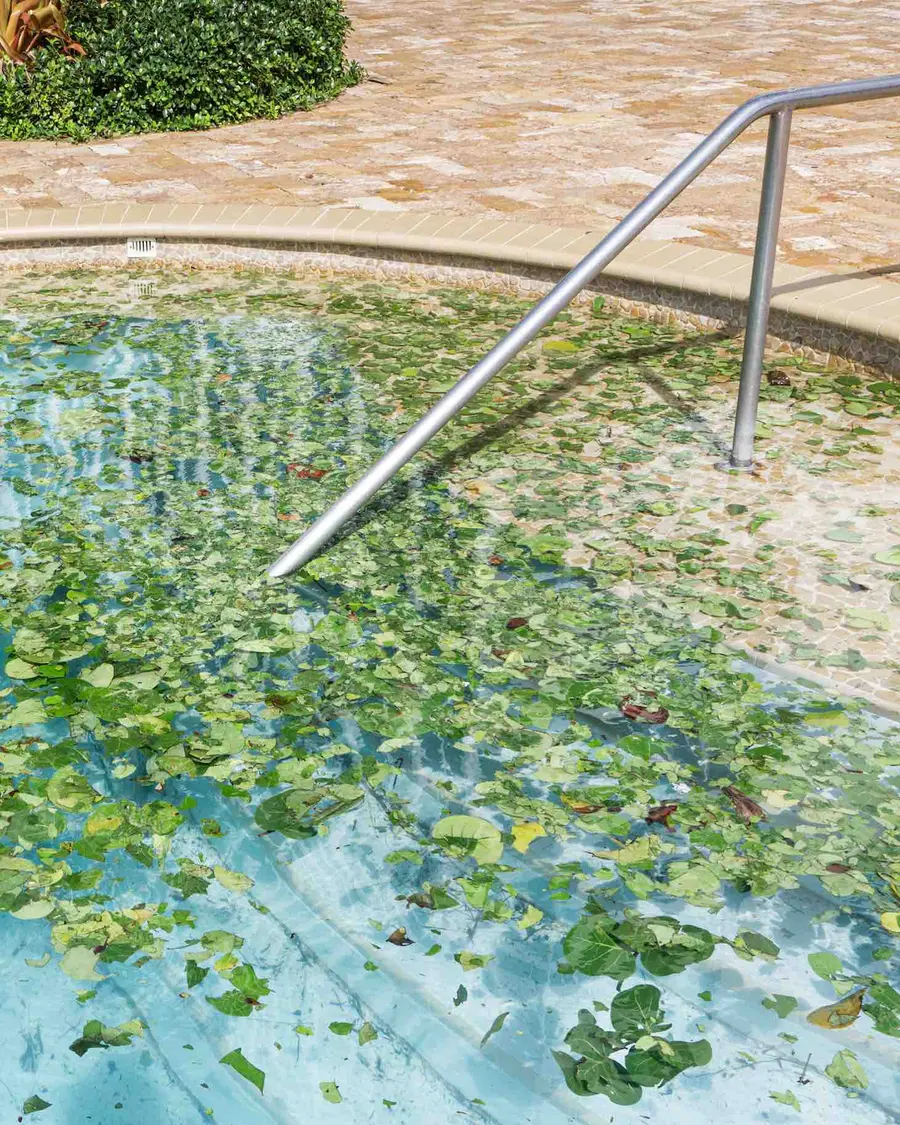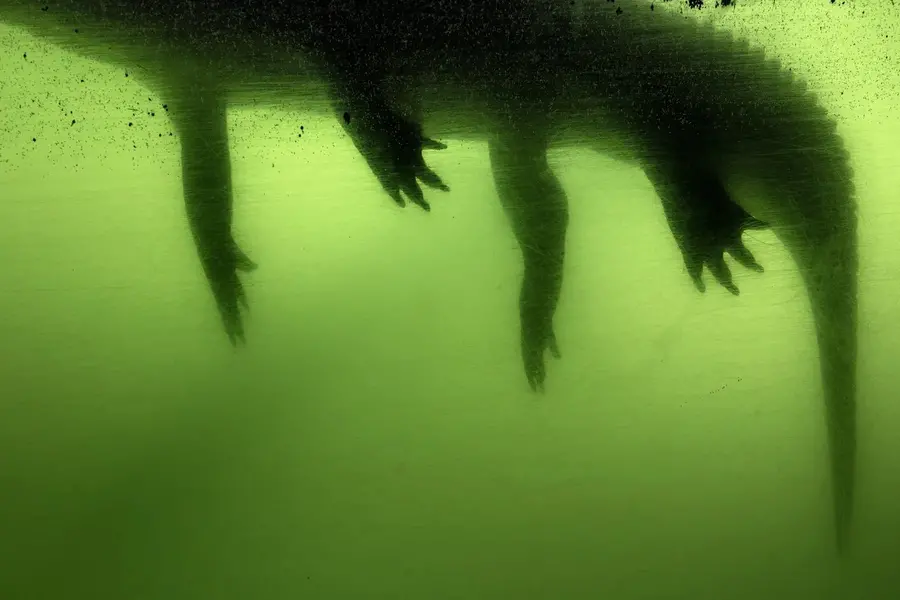Life in Miami on the Knife’s Edge of Climate Change
Read a version of David Campany's original FloodZone publication text, 'Coming Water', adapted for The New Yorker's Photobooth.
Full ArticleWe're open every day until Tuesday 23 December at 6pm.
Last postage dates for festive shopping: gift memberships by 16 December and shop orders by 19 December! We're closed from 24 December - 1 January. Re-opening on Friday 2 January 2026. Check our visit page for more info.
Begun in 2016, and with added momentum after hurricane Irma in 2017, Samoylova’s ongoing series of photographs reflects the vanity and precarity of everyday life in a cosmopolitan city founded on fever dreams and formed by images of touristic escape and luxury development.
– Heather Diack, from the essay 'Life on Planet Florida', DBPFP22 Catalogue
In the sweltering summer of 2016, the year in which Anastasia Samoylova moved to Miami, the city registered new records for heat. Each passing year has brought higher temperatures still, while the devastation of Hurricane Irma, which hit South Florida in 2017, led to an evacuation of over 6.5 million Floridians and caused an unimaginable $50 billion damage in the United States alone. Samoylova was not able to evacuate and continued her practice, first established when she moved to Miami – walking the streets of the city and photographing her surroundings as a way to establish a sense of place. She found something sublime in vistas typically tourist-clogged, now empty of people, and in nature asserting its rogue dominance. Storm surges, high tides and climate crisis as a lived reality, rather than an abstract threat, are prompts for Samoylova’s expansive and ongoing photographic series FloodZone. It would, however, be reductive to consider FloodZone as principally a record of environmental catastrophe. Instead, it is the dissonance between constructed and natural landscapes that is Samoylova’s compelling concern, and one that runs across multiple bodies of work. Tourism and property development form the iconography of South Florida, and the colour palette of Miami – a city deeply invested in its own image and tropical allure – is pastel-pretty. Yet everywhere there are signs of peril and rot. Mould blooms on a building-side, concrete erodes, palm trees bend, and tourist billboards and real estate advertising cover crumbling facades and ill-conceived construction sites. Attentive to the proliferation of such aspirational imagery, as well as creating her own seductive and unsettling images, Samoylova exposes the role that photography plays in the construction of imagined geographies and collective memory.
Star billing belongs to Anastasia Samoylova who looks at the impact of climate change on US coastal cities with a great eye for composition, whether it be capturing an alligator underwater, or trees bent over by a storm contrasting with the pink pavement around them.
The Londonist
When did your relationship to photography begin, and what qualities continue to draw you to it?
20 years ago I enrolled in the Environmental Design program at the Russian State University for the Humanities in Moscow. The programme was rooted in Bauhaus and Constructivism; we made architectural models by hand and then photographed them for critiques. Those early utilitarian images made me reflect on photography’s ability to transform scale and alter our perception of space. Through years of researching the various aspects of picturing places and exploring different approaches towards visualising the complex layers that comprise the field of environmental studies, I arrived at documentary photography. I was focused on the subjects and not as much on the aesthetics, using photography’s ingrained seductive quality to initiate a dialogue with a wider audience than a typical visitor of a gallery. Among other things, I am drawn to photography for its democratic potential, its ability to travel far and wide.
What’s the story behind your DBPFP22 nominated project? Tell us about how the seeds of an idea took form…
I moved to Miami in 2016 and began documenting the surroundings first simply to process my relocation. Throughout Miami’s streets and highways I found myself immersed in a kaleidoscopic world of idealised versions of the city depicted in a myriad of billboards, printed construction fences and ads. That year I also experienced my first hurricane with its alarming consequences and continued my speculative shooting routine, focusing more closely on the signs of environmental vulnerability in the area. The following year a major hurricane hit South Florida and it became clear that the city’s buildings and infrastructure weren't prepared to withstand the increased risks due to rising sea levels. I found the dichotomy between the precarious reality and the projected fantasy image of Miami as a tourist paradise and solid opportunity for real estate development darkly ironic and highly symbolic. Thus began FloodZone, a project about those contrasts in perception and looming climate anxiety; it is comprised largely of metaphorical images, rather than literal depictions of climate change. Despite the devastation I have seen, I remain an optimist, albeit with a realistic perspective that certain places and human life within them, including my home state, will be dramatically transformed in the next few decades. Without being didactic or adhering to photojournalistic principles, I hope my photographs resonate with those willing to pause and unpack the layers within them. I am preoccupied with the psychology of places and always aim to visualise their nuances as encountered by an everyday person, providing a humanistic, and perhaps female, perspective
What would you say the core themes of your work are?
My work explores how photography is used to illustrate concepts of beauty and nature in contemporary visual culture by examining and creating photographic typologies of natural and human-intervened landscapes. In 2013 I began what was to become a long term project, Landscape Sublime, that challenges traditional landscape depictions in advertising and social media in which algorithms of popular taste have taken notions of the sublime that emerged in eighteenth-century Western art to an extreme. In response, I printed and assembled sourced images into three-dimensional installations that I rephotograph, with the final images falling between depictions of true physicality and computer-generated illusions. FloodZone similarly responds to the power images have in shaping understandings of the world, capturing environmental changes in Florida with a broad range of photographs that coalesce into an acute perspective on life in an at-risk area amid forces that deny those very risks. The recently published Floridas project also takes as its subject the unique forms of nature and culture that only occur in the sunshine state. These photographs capture the seductions and disappointments of a place that has come to symbolise the contradictions of the United States today, and build on images by photographers who have come before, notably Walker Evans. My newest project Image Cities takes a global view of postindustrial cities that share an ever-collapsing integration of the photographic image and the built environment. Moving through Moscow, Paris, New York, and London, among others, the project highlights shared facets of the cities’ urban landscapes as well as their individual attempts to promote themselves via the repurposing of select aspects of their histories. Overall, my work incorporates observational photography, studio practice, and installation, utilising tools and strategies related to digital media and commercial photography to explore environmentalism, consumerism, and the picturesque.
Is there a favourite journey you’ve taken for your work? Describe it to us!
In 2018 while actively working on the FloodZone project I took a road trip to the west coast of Florida to photograph an unusual structure, whose story had fascinated me for years. The Cape Romano Dome House looks like it could belong to a sci-fi movie set, but it was in fact a functioning vacation home built by an oil magnate in the 1980s. It was initially located on land, with a 700 ft setback from the shore, but it is now entirely cut off by the encroaching water. The house has no landings or dock facilities as it was never meant to be accessible by boat. Right now boating is the only way to reach it and I had to rely on a captain to navigate the shallow muddy waters, our journey interrupted by a large pod of dolphins hunting along our route. The surreal looking structure now serves as a landing spot for migrating birds and an artificial reef for marine life. That trip also inspired me to pursue a parallel project, Floridas, as I discovered an archive of 32 photographs from the west coast of Florida made by Walker Evans in the 1940s. The book of the project was published by Steidl in 2022 and contains both my images and rarely seen historic photographs and paintings of Florida by Walker Evans.
Do you have a favourite image from your nominated work to tell us the story behind?
While I don’t have a single favourite image – because all 86 of them in the book are integral to the whole story – the most meaningful one for me is the Flooded Garage. The composition is simple – a child wearing a bike helmet standing ankle-deep in a pool of dark water in a flooded building, my shadow in the afternoon sun to the right. I took this photo the day after Hurricane Irma hit Florida in 2017 as a Category 4 storm. The boy is my son Mark and the garage was in the basement of our apartment building at the time. After a year of photographing in Miami with no set agenda that day I witnessed devastation I could not have imagined prior. The urgency of the situation became obvious and I set out to communicate my everyday experiences here with a clearer focus and in the most direct way: through a series of documentary style photographs that could appeal to a wide audience, inspire a dialogue, invite reflection on the phenomenon that is occurring right at this moment – not in some distant future, or in some faraway land, but here, in a dense urban landscape of a seemingly thriving city. The project has since expanded to the other southern states and up the East Coast of the US. It is ongoing.
Throughout Miami’s streets and highways I found myself immersed in a kaleidoscopic world of idealised versions of the city depicted in a myriad of billboards, printed construction fences and ads. That year I also experienced my first hurricane with its alarming consequences.
– Anastasia Samoylova
A Further Reading List From Anastasia Samoylova
Goodell, Jeff. The Water Will Come: Rising Seas, Sinking Cities and the Remaking of the Civilized World, 2017
Rush, Elizabeth. Rising: Dispatches from the New American Shore, 2018
Wallace-Wells, David. The Uninhabitable Earth, 2019
Ariza, Mario Alejandro. Disposable City: Miami's Future on the Shores of Climate Catastrophe, 2020
Groff, Lauren. Florida, 2018
Read a version of David Campany's original FloodZone publication text, 'Coming Water', adapted for The New Yorker's Photobooth.
Full ArticleAde J. Omotosho considers FloodZone for Hyperallergic.
Full ArticleSusan Sontag, rising sea levels and moving to Miami: An in conversation with Anastasia for Vogue
Full ArticleAnastasia Samoylova at Dot Fiftyone by Heather Diack for Artforum's Critic's Picks, August 2020
Picturing Climate Crisis in Miami by Monica Uszerowicz for The New York Review of Books, May 2020
Landscape Sublime: Follow Oolite Arts resident artist Anastasia Samoylova as she explores Miami with her camera.
Anastasia presents a lecture about FloodZone for the Museum of Contemporary Photography, Chicago
Anastasia speaks about FloodZone to New Climate Narratives, a documentary podcast investigating our changing climate through experts and leaders who are engaging, imagining, and creating new ways forward.
Using her own experience as a starting point for exploration, Samoylova’s images vacillate between appeal and repulsion, paradise and catastrophe. But her record of climate crisis is less direct reportage than lyrical evocation. The colour palette is tropical and pastel-pretty, but there is peril too: rot, wear and decay becoming apparent under the glossy surface. Samoylova plays with the proliferation of aspirational lifestyle imagery that forms the region’s official iconography, but which exists in stark contrast to the realities of encroaching environmental disaster. From aerial views of saturated landscapes to close-up observations of weather worn, architecture, displaced fauna and resilient flora, Samoylova captures the ‘seductive and destructive dissonance’ of a region deeply invested in its own image and sunny allure, while dangerously impacted by rising sea levels, storm surges and coastal erosion, brought about by climate change.
Samoylova grew up in Moscow in the final years of the Soviet Union and a relationship to idealised, near-Utopian images played out in her apprehension of both the failed Soviet project and of her future home, the United States. There was, however, an inevitable discrepancy between the imagined version of America and the reality Samoylova encountered. She began to contemplate how the perception of places is shaped by the images we encounter prior to, or alongside, the firsthand experience of navigating those places. Similarly, while undertaking a Master’s degree in Environmental Design, it was an assignment to photograph her architectural prototypes, which were constructed out of paper, that spurred her thinking about photography’s relationship to three-dimensional space and to illusion. In the end, Samoylova preferred her photographs to her buildings, but the interest in paper models and constructed environments remained. This found particular expression in the series Landscape Sublime, 2013-ongoing. Focusing, even then, on idealised and mass-distributed images of nature, her constructed landscapes were sourced from the internet and assembled in the studio. In her latest project, Image Cities, Samoylova focuses on the integration of photography and commercial images in the urban environment. It is Samoylova’s achievement, through her own act of virtuosic image-making, to expose photography’s complicity in creating an ideological divide between a projected identity and the reality of urban living. In her recently published project, Floridas (Steidl, 2022), Samoylova presents a complex psychological portrait of the state, while establishing a dialogue with the historic images of Walker Evans, who documented the region over the course of several decades. Samoylova portrays Florida in all its intensity as a stark place – culturally, politically, economically and climatically. While Florida and the adjacent southern states comprise the first iteration of FloodZone, Samoylova’s project is ongoing as yet more communities face the reality of rising sea levels.
Samoylova has had solo exhibitions at the HistoryMiami Museum; Chrysler Museum of Art, Virginia; The Print Center, Philadelphia; Multimedia Art Museum, Moscow; and Contemporary Art Museum, Tampa. In 2022 FloodZone will be presented in an extensive solo exhibition at the Eastman Museum, New York. Samoylova was awarded a number of grants, including the Fundación MAPFRE KBr Photo Award, South Arts Fellowship and Michael P. Smith Fund for Documentary Photography.


